The Oceanic Platform of the Canary Islands (PLOCAN) leads the European project FLOTANT which objective is to develop an innovative, integrated, Floating Offshore Wind solution, optimized for deep waters (100-600m) and to sustain a 10+MW wind turbine generator.
The technical coordination of the FLOTANT project is supported by the COBRA Group, a global benchmark with the capacity and determination to develop, create and operate industrial infrastructures. 17 partners from different countries such as United Kingdom, Germany, Netherlands, Ireland, France, Greece, Croatia and Slovenia participate in this project.
The main objective of FLOTANT project is to develop the conceptual and basic engineering, including performance tests of the mooring and anchoring systems and the dynamic cable to improve cost-efficiency, increased flexibility and robustness to a hybrid concrete-plastic floating structure implemented for Deep Water Wind Farms. Innovative solutions will be designed to be deployed in water depths from 100m to 600m, optimizing the Levelized Cost of Energy of the floating solution. The FLOTANT consortium includes companies and entities such as ESTEYCO SA, Innosea, Future Fibres, the University of Exeter or the University of Edinbourgh.
The FLOTANT project celebrated its first General Assembly in Madrid at COBRA facilities with the participation of the 17 partners. During the assembly, the main lines of action were defined and discussed.
According to WindEurope report, offshore wind is expected to produce 7% to 11% of the EU’s electricity demand by 2030, as offshore wind energy could have an average cost of 54 €/MWh in the most favourable locations.
Energy produced from turbines in deep waters could meet the EU’s electricity consumption four times over, according to estimates from WindEurope. In consequence, encouraging the development and deployment of offshore wind in deep waters is a key strategic issue for EU.
FLOTANT has received funding from the European Union’s Horizon 2020 research and innovation programme under grant agreement No. 815289



